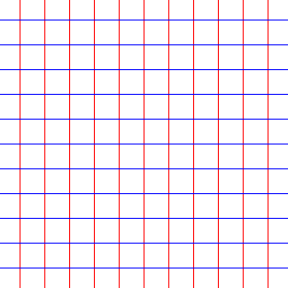Conformal symmetry
In mathematical physics, the conformal symmetry of spacetime is expressed by an extension of the Poincaré group. The extension includes special conformal transformations and dilations. In three spatial plus one time dimensions, conformal symmetry has 15 degrees of freedom: ten for the Poincaré group, four for special conformal transformations, and one for a dilation.
Harry Bateman and Ebenezer Cunningham were the first to study the conformal symmetry of Maxwell's equations. They called a generic expression of conformal symmetry a spherical wave transformation.
Generators and commutation relations
The conformal group has the following representation:[1]
where are the Lorentz generators, generates translations, generates scaling transformations (also known as dilatations or dilations) and generates the special conformal transformations.
The commutation relations are as follows:[1]
other commutators vanish.
The definition of the tensor is omitted.
Additionally, is a scalar and is a covariant vector under the Lorentz transformations.
The special conformal transformations are given by[2]
where is a parameter describing the transformation. This special conformal transformation can also be written as , where
which shows that it consists of an inversion, followed by a translation, followed by a second inversion.


In two dimensional spacetime, the transformations of the conformal group are the conformal transformations. There are infinitely many of them.
In more than two dimensions, Euclidean conformal transformations map circles to circles, and hyperspheres to hyperspheres with a straight line considered a degenerate circle and a hyperplane a degenerate hypercircle.
In more than two Lorentzian dimensions, conformal transformations map null rays to null rays and light cones to light cones with a null hyperplane being a degenerate light cone.
Uses
The largest possible (global) symmetry group of a non-supersymmetric interacting field theory is a direct product of the conformal group with an internal group.[3] Such theories are known as conformal field theories.
One particular application is to critical phenomena (phase transitions of the second order) in systems with local interactions. The fluctuations in such systems are conformally invariant at the critical point. That allows for classification of universality classes of phase transitions in terms of conformal field theories. Conformal invariance is also discovered in two-dimensional turbulence at high Reynolds number.
Many theories studied in high-energy physics admit the conformal symmetry. A famous example is the N=4 supersymmetric Yang-Mills theory. The worldsheet in string theory is described by a two-dimensional conformal field theory coupled to the two-dimensional gravity.
See also
- Coleman–Mandula theorem
- Renormalization group
- Scale invariance
- Superconformal algebra
- Conformal Killing equation
References
- 1 2 Di Francesco; Mathieu, Sénéchal (1997). Conformal field theory. Graduate texts in contemporary physics. Springer. p. 98. ISBN 978-0-387-94785-3.
- ↑ Di Francesco; Mathieu, Sénéchal (1997). Conformal field theory. Graduate texts in contemporary physics. Springer. p. 97. ISBN 978-0-387-94785-3.
- ↑ Juan Maldacena; Alexander Zhiboedov (2013). "Constraining conformal field theories with a higher spin symmetry". Journal of Physics A: Mathematical and Theoretical. 46 (21): 214011. Bibcode:2013JPhA...46u4011M. doi:10.1088/1751-8113/46/21/214011.